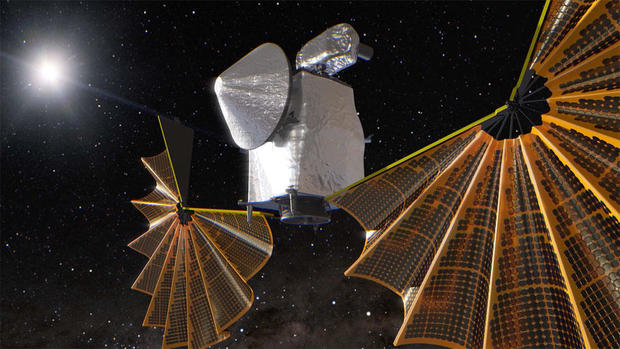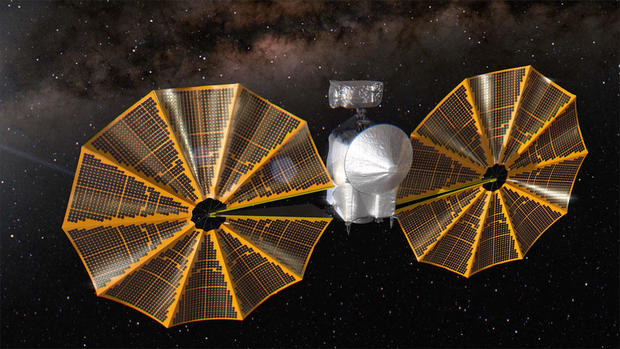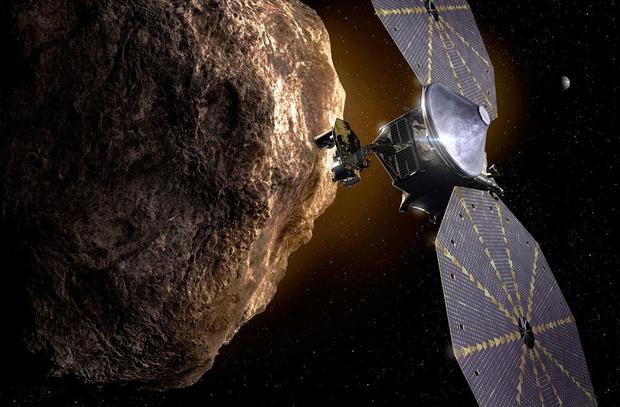NASA studying solar array issue with Lucy asteroid probe
NASA's $1 billion Lucy asteroid probe is safely on its way, but engineers are studying telemetry indicating one of its two circular solar arrays may not be fully deployed and latched in place, the agency said in a blog post Sunday.
Lucy was launched from Cape Canaveral early Saturday atop a United Launch Alliance Atlas 5 rocket and released on a trajectory setting up two velocity-boosting gravity-assist Earth flybys in 2022 and 2024 to fling the craft out to a swarm of asteroids sharing Jupiter's orbit.
A third Earth flyby is planned for 2030 to send the craft to a pair of asteroids in another "Trojan" swarm in 2033.


Built by Lockheed Martin Space, Lucy will be operating farther from the sun than any other solar-powered spacecraft before it, and its two Northrop Grumman-built arrays, designed to unfold 360 degrees like Chinese fans, are critical to mission success.
Shortly after launch Saturday, NASA confirmed both 24-foot-wide arrays had deployed and were generating power. But on Sunday, the agency said one of the arrays may not be latched in place.
"Following a successful launch ... analysis of NASA's Lucy spacecraft systems show the spacecraft is operating well and is stable," the blog post said. "Lucy's two solar arrays have deployed, and both are producing power and the battery is charging."
"While one of the arrays has latched, indications are that the second array may not be fully latched. All other subsystems are normal. In the current spacecraft attitude, Lucy can continue to operate with no threat to its health and safety."

It's not yet clear whether the array in question is, in fact, fully deployed but not latched in place or whether it did not reach full deployment and is not generating the same amount of power as its counterpart. It's also not yet clear whether Lucy can safely fire its maneuvering thrusters with an unlatched array.
Thomas Zurbuchen, NASA's science chief, said he was confident engineers will resolve the problem.
"The two solar arrays have deployed, but one may not be fully latched," he tweeted. "The team is analyzing data to determine next steps. This team has overcome many challenges already and I am confident they will prevail here as well."
NASA’s #LucyMission is safe & stable. The two solar arrays have deployed, but one may not be fully latched. The team is analyzing data to determine next steps. This team has overcome many challenges already and I am confident they will prevail here as well https://t.co/8IYs8bJhKM pic.twitter.com/oICOA3ksre
— Thomas Zurbuchen (@Dr_ThomasZ) October 17, 2021
Whether intentional or not, Zurbuchen's tweet included a frame from the Goddard animation above showing one array fully deployed and one with a gap indicating a partial deployment.
- In:
- Mars
- NASA

Bill Harwood has been covering the U.S. space program full-time since 1984, first as Cape Canaveral bureau chief for United Press International and now as a consultant for CBS News. He covered 129 space shuttle missions, every interplanetary flight since Voyager 2's flyby of Neptune and scores of commercial and military launches. Based at the Kennedy Space Center in Florida, Harwood is a devoted amateur astronomer and co-author of "Comm Check: The Final Flight of Shuttle Columbia."
TwitterDisclaimer: The copyright of this article belongs to the original author. Reposting this article is solely for the purpose of information dissemination and does not constitute any investment advice. If there is any infringement, please contact us immediately. We will make corrections or deletions as necessary. Thank you.







